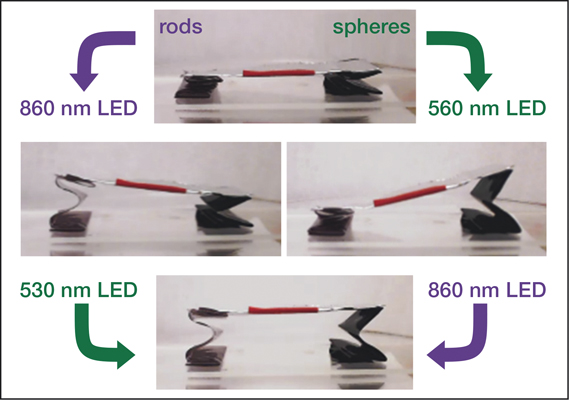The multicomponent structure of shape-memory polymers allows different phases in the material to melt or flow at different temperatures. Subsequently, actuation of these devices requires controlled heating. Remote control using light to drive complex processes will enable new applications in soft robotics. Joseph B. Tracy from North Carolina State University, along with his former graduate student, Sumeet R. Mishra, embedded gold nanoparticles into a shape-memory polymer and achieved sequentially controlled actuation. Essential to their success was the control over geometrical shapes of plasmonic gold nanoparticles. In turn, materials dissimilarly absorb different colors of light and, subsequently, photothermally heat in fine-tuned responses to specific optical wavelengths. The researchers embedded these optically powered nanoheaters into a polyurethane shape-memory polymer, which is thermoplastic and has a component with a low glass-transition temperature, and bent strips of these materials into accordion-shaped legs. Different wavelengths of light then selectively drove the unfolding of these legs. The researchers published their discovery in a recent issue of ACS Applied Nano Materials (doi:10.1021/acsanm.8b00394).
“This is an important advance because it directly connects the tunable optical properties of noble metal nanoparticles with remote triggering of sequential processes for applications in soft robotics, such as biomedical implants,” Tracy says. “Selection of light sources and several parameters, including peak wavelength, power, and distance from the sample have to be carefully balanced to achieve sequential actuation within a few seconds,” Mishra adds.

A wavelength-controlled stage with accordion legs containing gold nanorods (left) and gold nanospheres (right). The sequence of illumination by light-emitting diodes (LEDs) positioned next to each leg (not shown in photographs) remotely controls the tilt angle and height of the stage. Credit: Sumeet R. Mishra.
Because of the small size of the gold nanoparticles (<100 nm) and capabilities to functionalize surfaces, they can be potentially incorporated into a wide range of polymers. The shape of the nanoparticles and their concentration adjust their sensitivity to light for driving actuation. For example, gold nanorods generate heat when illuminated by light with a wavelength of 860 nm (near-infrared), while gold nanospheres respond to light with a wavelength of 530 nm (green). A common light-emitting diode produces sufficient intensity for absorbing gold nanoparticles to control the shapes of these actuators. This advantage simplifies control over shape-memory polymer devices and makes their operation safer than lasers and less expensive.
The research team designed a stage with accordion-shaped legs and adjusted the loading of nanoparticles and illumination time to control the height and tilt angle of the top of the stage. This design approach could be adapted for more complex soft robots for a wide range of remotely controlled applications in materials and biomedical engineering.




